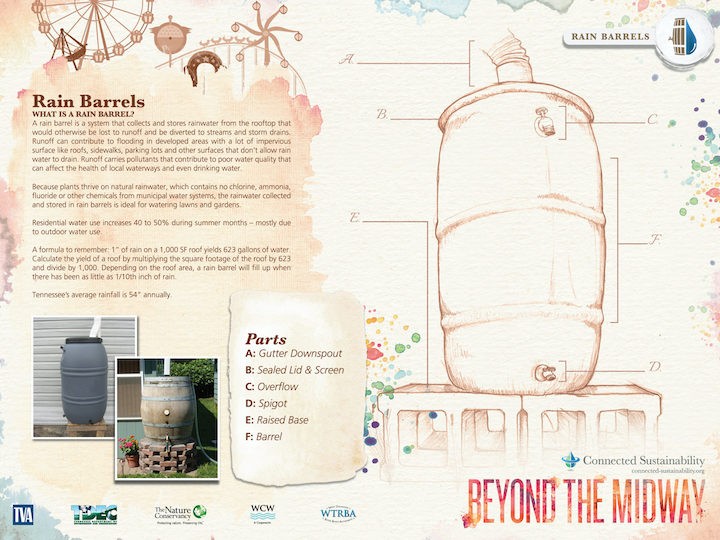Hey, hey, little playmate, come out and play with me
And bring your dollies three.
Climb up my apple tree, holler down my rain barrel,
Slide down my cellar door, and we’ll be jolly friends forever more.
Most of us sang the nursery song without giving a thought to the actual words, but at one time, people routinely kept rain barrels, recognizing the value of keeping a free source of water for outside needs. In fact, archeology shows us there was a process for collecting rainwater for agricultural use in cisterns from sites older than 2000 years. In the United States in the 1800s dry goods were frequently shipped in barrels. These barrels were quickly repurposed to collect and store rainwater. The absence of chemicals in rainwater made it suitable for bathing, to laundering clothing and watering gardens and livestock.
A rain barrel revival.
Following World War II, plastics became the chief form of packaging, and the easy access to shipping barrels for conversion to rain barrels diminished. That, along with improved access to drinking water, contributed to a decline in the use of this simple water collection strategies.
Water shortages and droughts have brought rain barrels back to popularity in the United States, so what’s old is new again. The rain barrel has made a comeback with shopping sites charging substantial prices for one. However, there are instructions available online to guide you through the steps for building your own for as little as $15. Many municipalities will offer discounts for rain barrels and hold workshops on rain barrel construction for interested residents.
Why Use a Rain Barrel?
It’s FREE! Rainwater comes straight off the eaves of homes and commercial structures. A rain barrel is a system that collects and stores rainwater from the rooftop that would otherwise be lost to runoff and be diverted to streams and storm drains. That means that not only do you get the benefit of using the rainwater from your roof for your gardens for free, but you also are helping to mitigate flooding in developed areas by stopping the water from pooling on impervious surfaces like roofs, sidewalks, parking lots and other surfaces that don’t allow rainwater to drain. This “runoff” water picks up pollutants as it floods and makes its way gradually to storm drains. These oils, chemicals, debris contribute to poor water quality that can affect the health of local waterways and even drinking water.
How much water can you collect?
Residential water use increases 40 to 50 percent during summer months – mostly due to outdoor water use. You can estimate what you can harvest by a simple formula: 1” of rain on a 1,000-square-foot roof is 623 gallons of water. You can calculate the yield of your roof by multiplying the square footage of the roof by 623 and then divide by 1,000. Depending on the roof area, a rain barrel will fill up when there has been as little as 1/10th inch of rain. Because plants thrive on natural rainwater, which contains no chlorine, ammonia, fluoride or other chemicals from municipal water systems, the rainwater collected and stored in rain barrels is ideal for watering lawns and gardens.
Wood homes benefit from rain barrels.
Diverting rainwater runoff is beneficial to preservation of the a home’s foundation and wood components. When designing your log or timber home floor plan as well as your landscaping plan, consider where rain barrels would be most beneficial, both in collecting rainwater and in using it for a multitude of purposes.
This article was contributed by Don Green, a LEED AP biologist who specializes in environmental policy, low impact development, green infrastructure, energy/water nexus, water quality, erosion and sediment control, stormwater and environmental education. Contact Don here. Rain Garden graphics courtesy of beyondthemidway.com.




